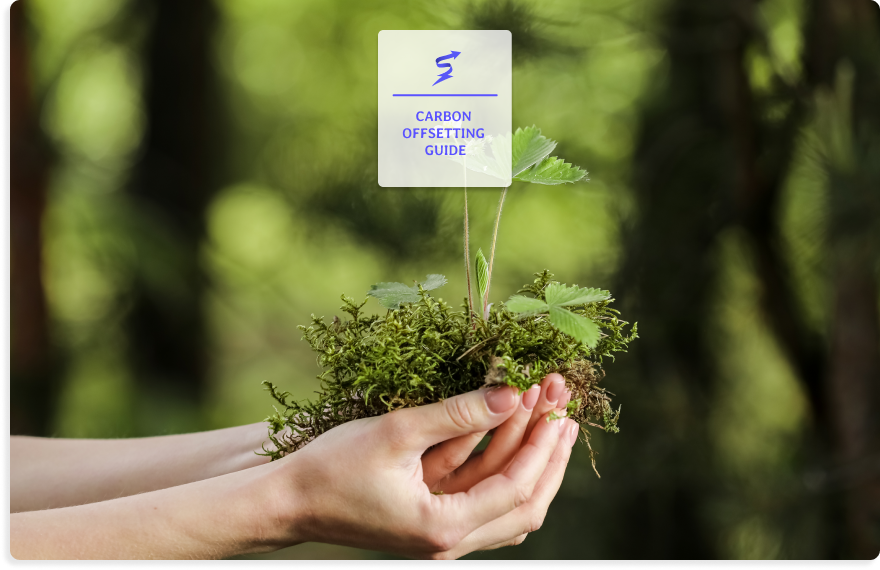Carbon Offsetting Guide

Looking for the best energy deals?
Request a callback from our experts at Switch-Plan to help you find
the best energy contract .
Notice
Carbon offsetting is one of the methods companies and individuals are using to reach their green objectives. More individuals and companies are setting bigger goals for themselves to become carbon neutral by carbon offsetting. When researching if carbon offsetting is right for you, many factors come into play that you will need to be aware of. These factors include knowing whether or not offsetting is a con, which are the best projects, and which are the different examples.
Last updated in: November 2022
To become an expert on carbon offsetting, this article will explain everything you need to know. It will give you an insightful view on what carbon offsetting is, why it is important, whether it is bad or not, and how you are able to offset as an individual.

What is carbon offsetting?
Carbon offsetting is a way to compensate for the emissions you create by funding an equivalent carbon dioxide saving somewhere else. It is common to find individuals and businesses carbon offset to reduce their carbon footprint. Individuals produce these emissions simply by driving to work or even heating our rooms.
Carbon offsetting is important because...
it allows anyone to invest in environmental projects around the world in order to reduce and balance their emissions. It gives individuals another way to help them reduce the carbon dioxide emissions that they release into the atmosphere in their everyday lives.

Looking for an energy deal that best fits your needs?
Free Service
We analyse the market to find you the best fitting deal on the market.
More info
How is carbon offsetting in the UK?
The UK government has set targets to achieve net zero carbon emissions by 2050. Here are different offsetting approaches that the UK government will be implementing to achieve its target:
- Woodland creation
- Household insulation
- Soils management: pasture
- Enhanced weathering
- Floodplain restoration
- Seagrass restoration
- Grassland
- Household low carbon heating
All of these approaches are reviewed through 17 different criteria. You can find the criteria here.
How much does carbon offsetting cost?
The cost of carbon offsetting depends on your own carbon emissions and it is not what you might expect. For example, different companies have different prices for the same offsetting projects. This is due to 2 main reasons. These reasons include:
- Several ways to estimate your impact on climate change
- Different costs for different projects
If individuals or organisations were more serious about tackling climate change, then these prices would increase quite rapidly. Once you have calculated your carbon emissions level, your broker will then let you know how much the fee is for your project.
A few examples of carbon offsetting include the following:
- Forestry - tree planting in areas that are facing deforestation
- Agriculture - farmers growing crops with technology and techniques to reduce waste
- ✈️ Aviation - airline operators optimising fight paths
- ♻️ Renewable energy - replacing fossil fuel use with clean, renewable energy such as a wind farm
- Water management - projects that get clean water to areas with polluted / contaminated water
- Waste management - projects that capture methane from landfills from waste disposal
- Carbon sequestration - Taking carbon out of the air and store it in areas such as soil, swamps, and trees
- ⚡️ Energy efficiency - project that aims to improve efficiency of existing infrastructure by upgrading building insulation
Is carbon offsetting bad?
Carbon offsetting is overall not bad, however, it can be unethical if it is the only effort you will be doing to reduce your carbon footprint. Below you can find a list of pros and cons of carbon offsetting:
✅ Pros
- You receive benefits from the chosen offset project
- When done right, carbon offsetting can positively impact climate change
- Increase in technological developments to track and monitor these projects
- There has been an increase in opportunities for projects.
❌ Cons
- It is not a complete solution in reducing GHG emissions
- Calculating emissions and carbon footprint is not precise
- Lack of consistency with several of these schemes. For example, several trees have been burned down after planting them, making the project not consistent.
- A study in 2016 on Clean Mechanisms analysed that the majority of these projects would result in additional emissions.
Is carbon offsetting the solution to climate change?
Carbon offsetting is definitely one of many ways that you can reduce your greenhouse gas emissions. However, if you are solely carbon offsetting, you need to keep in mind that it is not a solution. There are several solutions and other options that would be more efficient than offsetting.
Do offset projects actually deliver the carbon benefits they promise?
The majority of these offsetting projects do not fully deliver the carbon benefits that they promise us. Although they do reduce the carbon emissions that we are releasing to the environment, there are other solutions we can implement as well.
Doing these projects correctly can positively impact climate change if you implement other solutions as well.
Are Carbon offsetting plans essentially PR plans?
Funding and supporting an environmental project is not a PR plan. If these projects are done seriously, they can positively impact climate change.
How does carbon offsetting work?
You can offset by funding the same amount of carbon dioxide emissions to different environmental projects that stand out to you. Carbon offsetting is voluntary as any individual, business or organisation can pay a broker to remove the carbon that they produce in another part of the world. To carbon offset, you would need to follow the following:
- Calculate your emissions - Before contacting the broker of your choice, the individual or organisation must calculate their emissions.
- Pay - Once you have done the first step, you will be charged a fee on the level of carbon you or your organisation produces.
- Invest - Finally, that broker will invest that money in a project that reduces carbon emissions.
- Certificate - Once you have completed all of these steps, the individual or organisation will receive their own certificate or proof that they have carbon offset their emissions.
Can individuals offset their carbon emissions?
Yes, individuals can offset as well as small and large businesses. You can use a carbon footprint calculator to calculate your own emissions to have an idea of how much carbon dioxide emissions you will need to offset.
How can I become carbon neutral?
Being carbon neutral means that you are able to balance the carbon dioxide emissions that you release into the atmosphere with the amount that you absorb back.
10 ways to become carbon neutral include the following:
- ♻️ Offset
- Use digital technology
- Lead and communicate your plan
- Invest in staff engagement
- Establish your carbon baseline
- Seek accreditation
- Drive down emissions and empower employees
- Collaborate
- ✂️ Keep cutting
- Set science-based targets
![]()
What are carbon footprints?
Our carbon footprint is the number of greenhouse gases we generate in our atmosphere in our everyday life. These greenhouse gases that are being released into the air include carbon dioxide and methane by individuals, organisations, and communities.
How to become carbon neutral?
Being carbon neutral means that you have successfully calculated your carbon footprint and have reduced it to zero. Here are ways you can become carbon neutral include the following:
- Transportation - Driving less, having a green vehicle, reducing long flights, and driving efficiently are all different ways you can reduce your carbon footprint through transportation.
- Power Usage - Adjusting your power usage in your home can make a significant difference. You can reduce your cooling/heating, laundry usage, and unplug any unused chargers.
- Reduce your Shopping - Changing our purchasing habits by reusing, repairing, and recycling can reduce how much trash we produce.
- Dieting - A quarter of global emissions comes from our everyday food choices. Reducing food waste by using leftovers can make a significant difference. As well as buying local and in-season food, and overall eating less meat in our diets.
What are the different greenhouse gases?
The most common greenhouse gas that the majority of individuals produce through everyday life would be carbon dioxide. However, there are several different other greenhouse gases that we produce as well. These gases include:
- Methane
- Nitrous Oxide
- Hydrofluorocarbons
- Perfluorocarbons
- Nitrogen Trifluoride
- Sulphur Hexafluoride
Looking to find an energy deal that best fits you?Leave your phone number to request a call back from us!
Free Service
FAQ
🤨 How does carbon offsetting work?
When you carbon offset, you first have to calculate the emissions that you produce in your everyday life and then you invest in an emissions project.
🌱 What are examples of carbon offsetting?
A few examples of carbon offsetting include the following:
- Waste Management
- Energy efficiency
- Forestry
💭 Why is carbon offsetting bad?
Carbon offsetting is overall not bad however it shouldn’t be the only practice that you do to reduce your carbon footprint. There are many other ways you can reduce your footprint. A few examples include the following:
- Reducing power usage at home
- A vegeterian diet
- Using less transportation
Updated on 29 Jan, 2024
Ilona Terradot
Switch Plan specialist
A French-Colombian student at EDHEC Business School based in Barcelona, Spain. With a strong passion for digital marketing, she works in the UK SEO team, overlooking the content and its optimisation on Broadband's websites.
A French-Colombian student at EDHEC Business School based in Barcelona, Spain. With a strong passion for digital marketing, she works in the UK SEO team, overlooking the content and its optimisation on Broadband's websites.